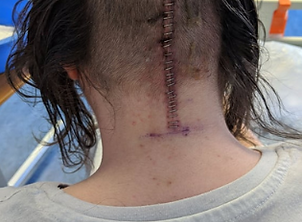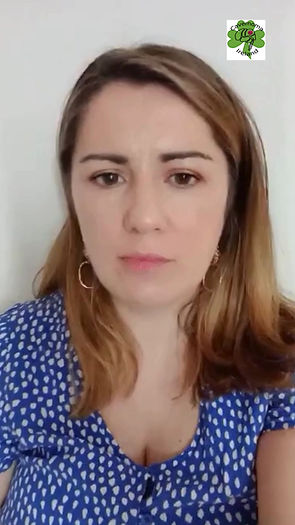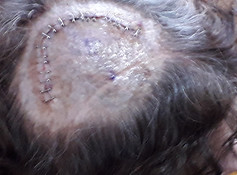
Patient Stories
Their lived experiences of cavernoma
"One day you will tell your story of how you've overcome what you are going through now and it will become part of someone else's survival guide"
Charlotte's Story

A cavernoma is a capillary that is particularly bad at doing its job, and it looks like a raspberry or popcorn on an MRI scan. It can leak blood into the surrounding tissue and can occur throughout the body usually with very little issues. Even when they occur in your brain they often cause little trouble, with many people having a ‘raspberry’ in there that behaves itself for their entire life.
There is a genetic version that is the rare disease and people with the genetic mutation often have multiple, even hundreds of cavernomas throughout their brain and spinal cord.
It is extremely rare for cavernomas to bleed. However, I have had the luck/joy of having my brainstem cavernoma bleed 3 times. I had my first symptoms of numbness in the left side of my face at the end of 2018. A month of this and I eventually see my GP who sends me off to A&E. After the CT showed nothing obvious, I went on my month-long trip to the US. I came back to an MRI and my first neurology appointment.
When the neurologist told me there was a reason for the symptoms I was delighted. I wasn’t crazy or imaging things up because of stress! I was told they weren’t exactly sure what it was but it was likely a venous malformation. Another scan was organised, and a referral sent to the neurosurgeon.
I met my neurologist again in March and told to not worry, it was probably a cavernoma, but the surgeon could answer more questions in May.
However before I could get to that appointment in April, I began to feel dizzy, nauseous and had trouble walking straight. I had the worst headache I had ever had and I ended up back in A&E. Eventually a scan was done that showed I was having a bleed. I spent a miserable Easter weekend curled up in bed, sleeping and trying not to puke. I was eventually started on steroids and slowly got better. I spent a total of 4 weeks there before being moved to a rehabilitation hospital for 5 weeks of learning my balance again, readjusting to my constant nausea and recovering.
I met my surgeon who told me that because my cavernoma was on my brainstem he would only ever consider surgery to remove it if I had had multiple bleeds in a year that had left me pretty badly off. I managed to sit my final exams over the summer and graduated college with my friends in September. I went back to work and had multiple check ups and just got back to life.
Shortly after Christmas I began to feel unwell again and I went to my GP. The GP managed to get in contact with my neurologist. I was sent up to hospital to get a scan and it showed I was having another bleed. It was only 8 months after the previous one. This time I was moved up to the neurosurgical hospital in Dublin where after multiple scans and tests, it was confirmed that I had a cavernoma and that now would be the best time remove it, as the next bleed may be much more severe and 3 bleeds in a year was a lot.
Surgery was not an easy decision as I could have been left with severe side effects such as losing the ability to swallow. I had surgery January 30th 2020, I was kept in a medical coma overnight and I began to wake up the next day. I then spent the next 4 days in the ICU and even took my first steps again there.
I had an incredible surgeon who managed to remove my entire cavernoma. I was able to swallow and move my facial muscles after surgery but I was left with nerve pain on the whole right side of my body, double vision, weakness and a loss of fine motor skills on my right side and having to learn to balance all over again. I was moved back to my original hospital and spent 3 weeks there recovering before going to the rehab hospital.
There I spent 3 more weeks improving my balance, practising fine motor skills and strengthening my right side. I then got to go home early, courtesy of Covid and I spent the rest of the summer recovering!
My double vision gradually went away and most of my symptoms improved hugely. I got back horse riding, swimming, hiking and was accepted and began my dream masters degree in September.
I don’t regret choosing to have surgery, although if things had worked out differently who’s to say I would feel the same. As unfortunate as the whole situation was, it was amazing to get to know so many different people, including the incredible people who looked after me at the different hospitals.
I learnt how lucky I am to have as many friends and family who visited me while I was in the hospital and their visits made each stay that much more bearable. It was also brilliant to be able to talk to others who had cavernomas and discover a whole community!
I got to meet people both in person at a Cavernoma Ireland meetup in December 2019 and virtually with CAUK since the pandemic began.
These virtual meetups have been an absolute joy to attend, whether they discussed the science behind cavernomas, patient experiences or were just a tea and chat. The entire community is a wonderful support to have, to be able to chat to them, ask questions if you’re worried and find out all about cavernomas.
Thank you so much for reading about my journey with cavernomas!
Aisling's Story

Sandra's Story

The past 19 year’s and counting.
The first symptoms I had, was on the right side of face, pain radiating from my teeth up to my eye, pressure around and at back of the eye. I went to the dentist, who could not see anything wrong with my teeth. But gave me antibiotics just in case.
A few days later no improvement, and had now got double vision. I went to the GP, who advised me of how high my blood pressure was, 200/110. He gave a prescription for medication and sent me out to the local hospital for an ultra sound on my kidneys (due to family history of kidney disease.) The GP was aware of the antibiotics I was already taking, from prescription the Dentist had gave me.
Over the weekend I got worse. We got a letter from the GP to go to A&E.
So, with blood pressure of 200/110, double vision, pain radiating from my teeth up my eye, pressure around and back of eye, weakness in my right arm, and a cracking headache – went to the A&E in Beaumont Hospital.
The doctor at the hospital said that “the concoction of medication alone” the GP had given me, “was enough to have him struck off”.
I had a CT scan. The A&E doctor told me nothing was found on the scan, to go back to my GP for treatment of blood pressure. That high blood pressure can
cause double vision.
The next morning, I got a phone call from Beaumont Hospital’s Neurology team. They had reviewed scans from the night before. They had found something on my scan, and wanted me to go back to the hospital straight away for admission.
As there were no beds available on a ward, I had to sleep that night in A&E. The doctor who had discharged me the night before, walked past my bed. “I sent you home last night”. The look of shock on his face as he read my chart. He apologised saying that he had not seen the scan himself, and was only going by what the radiologist had said.
My symptoms started to increase over the following days, weakness on my right-side leg and arm, the worse cracking severe exploding headache pressure ever. It felt like my head was in a vice. No pain medication could relieve it.
While in hospital I had physiotherapy. My glasses was fitted with prisms to help correct the double vision.
An ultrasound on my kidneys showed I had polycystic kidneys.
This left the doctors uncertain if the blood pressure was caused by my kidneys before the haemorrhage, or if the haemorrhage was causing my blood pressure to be so high.
Having polycystic kidneys, reduces the medications list available for doctors to choose from to give me, to considerably less. As most medication would have an impact on my kidney function.
After a bit of improvement, and no sign of any further bleeding from brainstem cavernoma, I was sent home from hospital with No information, No support, just the name ‘Cavernoma’.
I had to become my own expert in the disease. As it is rare not many medical professionals will know much about it or even heard of it. “Cav what?”
Doctors and nurses would not know what it is like, that yes the symptoms are because of cavernoma. I am living with it every day. I know when something has changed.
In 2006 – Eight months after my first haemorrhage, I started to get some symptoms that was similar to my first haemorrhage. I knew something was just not quite right, and my arm was starting to feel odd. I went to my GP (a different one, had changed GP’s).
I explained, that I felt I was having another bleed. He disregarded my concerns.
Took my blood pressure, said it was fine and sent me home.
A few days later I was attending Beaumont Hospital for a renal clinic appointment.
My arm had gotten worse. I was starting to have to hold it up. Before going to the renal clinic, I went to my neurosurgeon’s private office. With the hope of asking the secretary if there was any way I could see the surgeon or at least a member of his team.
As I was just about to knock on the door, my surgeon opened it.
He saw that I was holding my arm, and seen me straight away.
That evening (Thursday) I had an MRI. Went back for the results on the Monday.
By this time, I now had double vision.
The MRI showed that I had had another haemorrhage, from the same cavernoma in brainstem. Was at high risk of further haemorrhage’s, but surgery was not an option because of location of the cavernoma. Only treatment available was Gamma knife radiosurgery.
I had that done in Sheffield England, a few months after that haemorrhage. In 2006.
In 2007 – I had brain surgery to remove two cavernomas and a meningioma in the frontal-temporal lobe. The meningioma was increasing in size. (The gene CCM3 also causes meningioma tumours to develop). The neurosurgeon said that there was evidence of previous bleeding from the cavernomas he removed.
In 2020 – I had brain surgery to remove another meningioma. This time it was in the left extra-axial.
The tumour had grown in half its size since the previous MRI scan in 2017.
In 2024 I had brain surgery to remove another meningioma, in the right frontal lobe.
Currently I have 20 cavernomas.
I am not just living with the risk of a further haemorrhage, from any of my cavernoma.
Who have squatter’s rights!
I am also living with a range of invisible symptoms, including chronic pain, migraine, neuro-fatigue, tinnitus and many more.
An acquired brain injury.
It is vital to be connected to others that have the same condition.
I have been supported by Cavernoma Alliance UK and their members.
Together myself and Kay McGrath, started ‘Cavernoma Ireland’ in November 2018.
To support people living on the Island of Ireland who are affected by cavernoma, including their families, friends and carers.
Now a registered community group (with 3 people on management team), Cavernoma Ireland help to connect members with each other, give support and information.
“Knowing you are not alone, on this path. We stand together, supporting, and searching for a cure.”
Thank you for reading my story.
